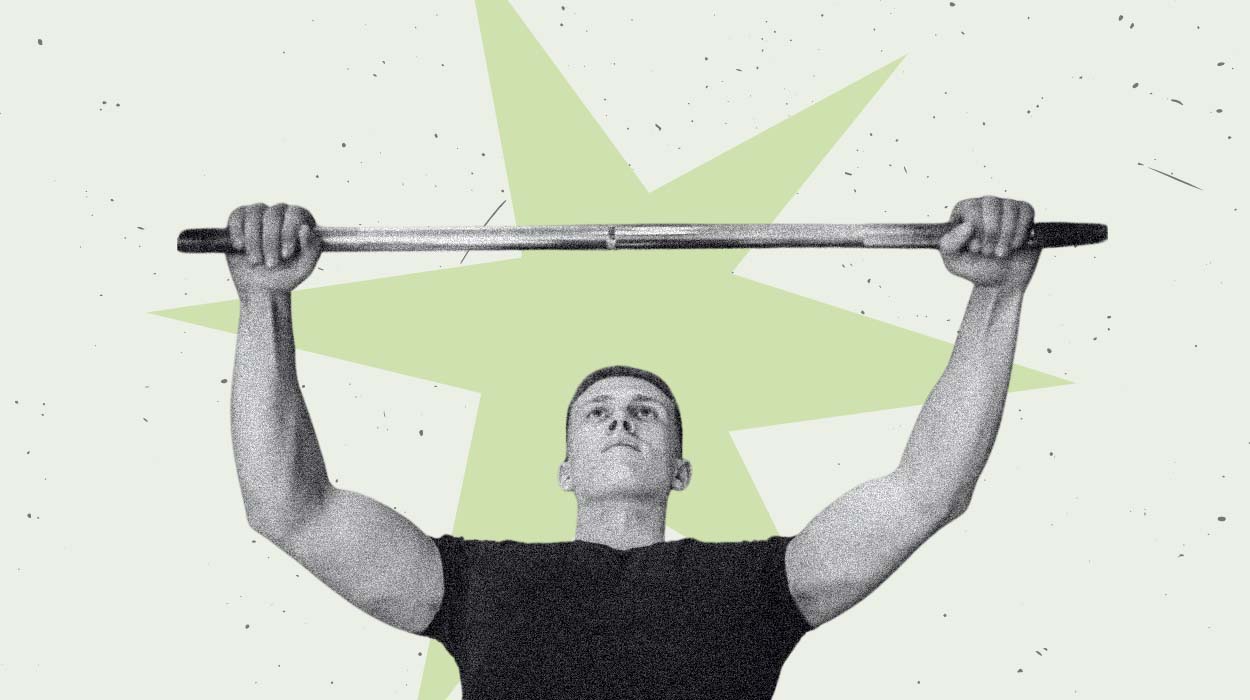
Most workouts you will find to work the chest involve bench press, maybe some flies and that’s about it. While these exercises generate strength and are excellent for the lower chest, if you exclude your upper chest, it can have detrimental effects on your strength, posture, and physique.
Those who neglect upper chest workouts end up developing an overpowering and unbalanced lower chest, less stability around the shoulder joint, and an odd chest shape due to unbalanced training. Knowing this should be plenty of reason to include some upper chest training in your workouts.
Here we have covered the most crucial information for upper chest workout, along with the five best exercises to include to balance out your training program.
Best Upper Chest Exercises
An upper chest workout improves overall chest development and shoulder stability. We suggest including our top five exercises at some point in your yearly training program.
- Incline Dumbbell Press.
- Incline Barbell Bench Press.
- Reverse Grip Bench Press.
- Incline Cable Crossover.
- Incline Hammer Strength Machine.
Upper Chest Workout: Best Exercises For Upper Chest In 2024
Alright, we can hear you. You want the exercises already! Well, without further ado, let’s jump right into the five best exercises for the upper chest.
Incline Dumbbell Press
The incline dumbbell press is one of the best dumbbell exercises to stimulate the upper chest muscle fibers. As a compound exercise, it activates the tricep muscles of the upper arm as well.
To get started, you will need an exercise bench set at an incline angle of 30-45 degrees. Then select a pair of dumbbells. How heavy and how hard should you exercise? That completely depends upon your ability and your goals.
The following steps can give you a good idea of how to perform the incline bench press with dumbbells safely and effectively.
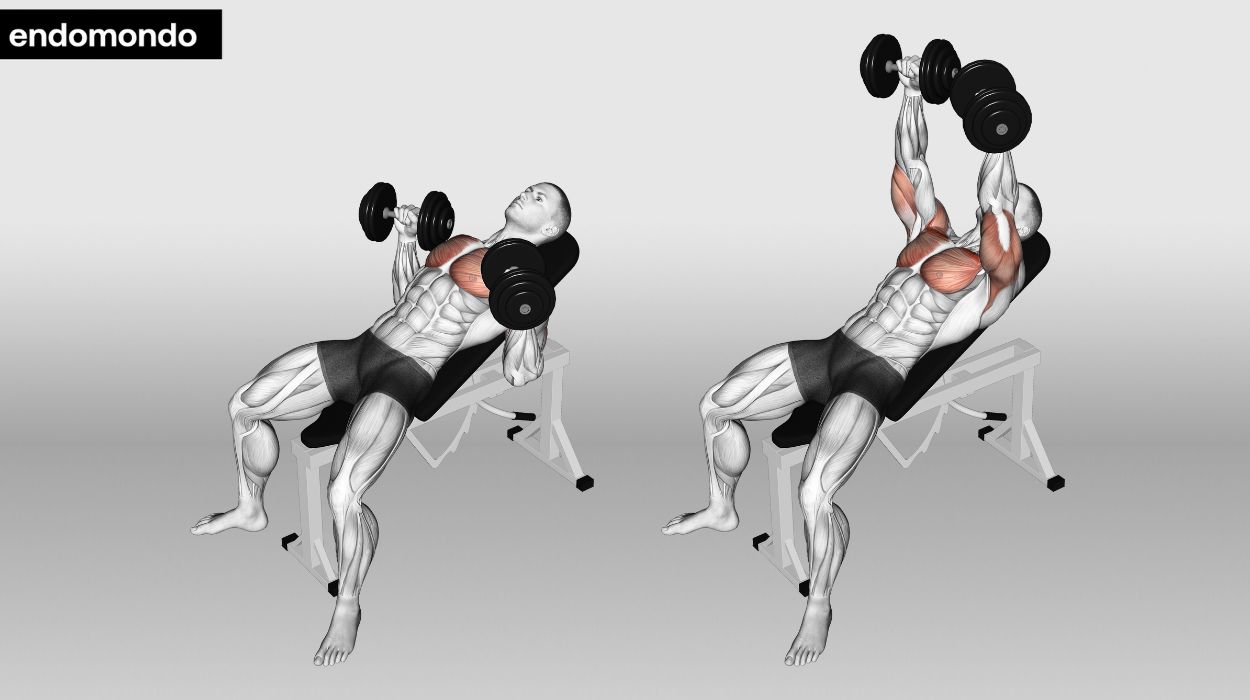
How to do:
- Sit on an incline bench with your feet flat on the floor and shoulder-width apart.
- Hold a pair of dumbbells in each hand, resting your thighs with your palms in a neutral position.
- Breathe in, kick the dumbbells up and at the same time, lie back against the exercise bench.
- Extend your arms straight above your chest.
- Breathe out and return the dumbbells to the starting position.
- Repeat for the desired number of reps.
Tips:
- Ensure your bench is set at a comfortable incline angle (usually around 30-45 degrees) to target the upper chest effectively and prevent excessive strain on the shoulders.
- Start with a weight that allows you to maintain proper form and control throughout the movement, gradually increasing the resistance as you progress.
- Focus on a full range of motion by lowering the dumbbells until they are at chest level, and then pressing them upward until your arms are fully extended for optimal chest activation.
Optimal Sets and Reps: 3 sets of 10-12 reps.
Incline Barbell Bench Press
Opposed to the flat bench press, an incline barbell press puts more emphasis on the upper chest muscles. This exercise is just like the incline dumbbell press, only using a barbell.
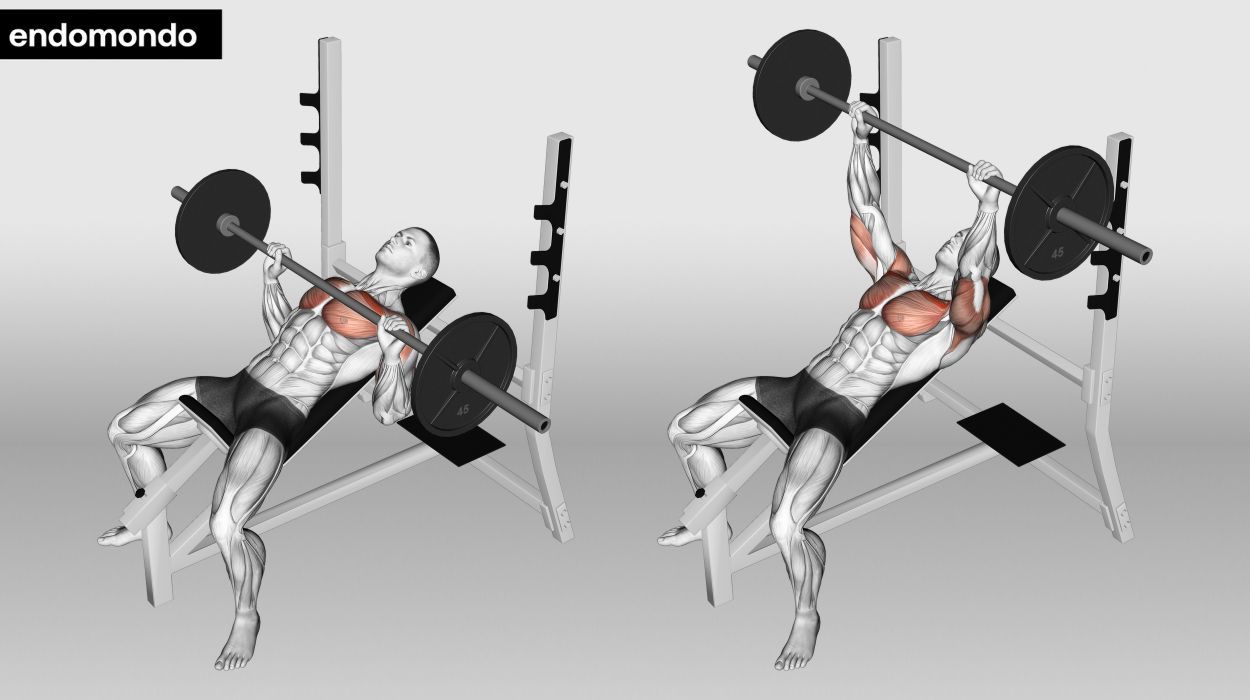
How to do:
- Place a barbell on top of a bench rack.
- Place the exercise bench underneath the barbell.
- Lie down on the exercise bench and position yourself so that the barbell is directly in line with your forehead.
- Grasp the barbell with an overhand grip just outside shoulder-width apart, and lift it off the rack.
- Lower the barbell to your upper chest.
- Upon the barbell touching the chest, push it back up.
- Repeat for the desired number of reps.
Tips:
- Ensure your bench is set at a comfortable incline angle (usually around 30-45 degrees) to target the upper chest effectively while maintaining proper shoulder stability.
- Maintain a strong and stable grip on the barbell, keeping your hands slightly wider than shoulder-width apart, and focus on controlled, even breathing throughout the exercise.
- Lower the barbell to your chest with control and press it upward explosively, emphasizing a full range of motion for optimal upper chest engagement.
Optimal Sets and Reps: 3 sets of 10-12 reps.
Reverse Grip Bench Press
The reverse grip bench press uses a flat bench, similar to the barbell bench press, but while grasping the barbell with an underhand grip.
It may seem odd to see a flat bench press exercise on the list, but the reverse grip bench press emphasizes flexion of the upper arm which has been shown to activate the clavicular head of the chest.
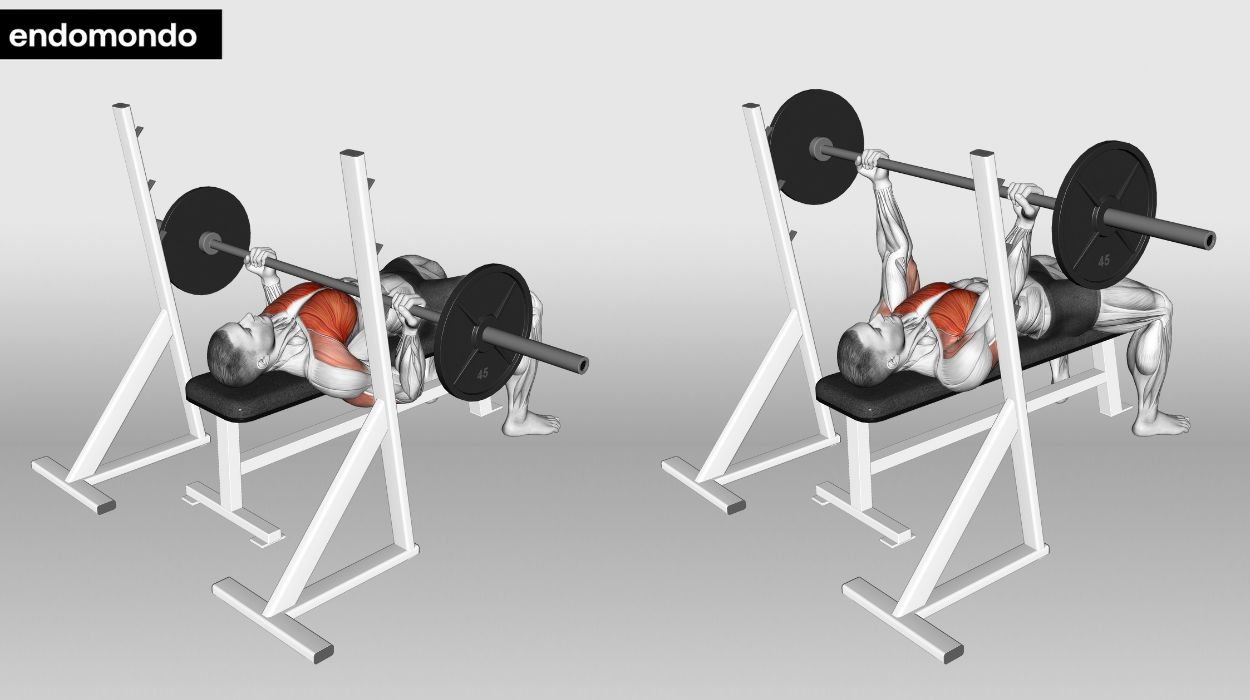
How to do:
- Set the exercise bench flat.
- Place a barbell on top of a bench rack.
- Place the exercise bench underneath the barbell.
- Position yourself so that the barbell is directly in line with your forehead.
- Grasp the barbell with an underhand grip at shoulder-width apart, and lift it off the rack.
- Lower the barbell to your lower chest.
- Upon the barbell touching the chest, push it back up.
- Repeat for the desired number of reps.
Tips:
- Use a spotter when performing heavy sets to ensure safety, as the reverse grip can be more challenging for some individuals.
- Keep your elbows close to your body and wrists aligned to avoid unnecessary strain on your joints.
- Focus on controlled, deliberate movements both while lowering the barbell and pressing it upward to maximize the engagement of your upper chest and triceps.
Optimal Sets and Reps: 3 sets of 10-12 reps.
Incline Cable Crossover
The next exercise on our list involves the cable machine. The incline cable crossover isolates the upper chest from eliminating any elbow movements, unlike other pressing exercises.
How does it work? Essentially, in a fly-like motion, you are bringing two cable crossover machines across the upper chest. See the instructions below.
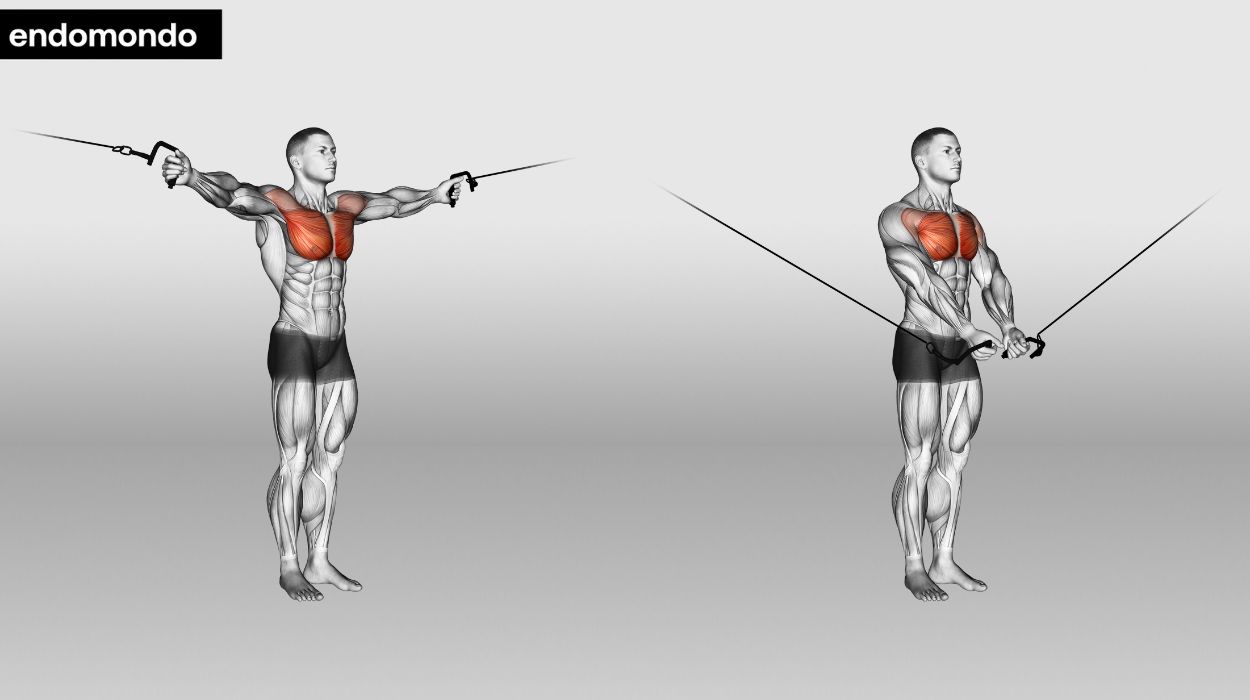
How to do:
- Set the cable machines in line with the collar bones.
- Attach a single handle on each side of the cable crossover machine.
- Grasp the handles and stand in the center of the machine.
- Lean forward, and with a slight bend in the elbows bring the arms across the upper chest.
- Slowly return arms to the starting position.
- Repeat for the desired number of reps.
Tips:
- Adjust the pulleys to a high position and choose an incline bench that’s comfortable for you to target the upper chest effectively.
- Maintain a slight bend in your elbows throughout the movement to protect your joints and focus on squeezing your chest muscles at the peak of the crossover.
- Perform the exercise with a controlled and deliberate tempo, emphasizing the mind-muscle connection for maximum chest activation.
Optimal Sets and Reps: 3 sets of 10-15 reps.
Incline Hammer Strength Machine
The incline hammer strength machine is a unique resistance exercise performed on a chest press machine. The range of motion for this exercise mimics the dumbbell press but with far less stress on the joints and tendons.
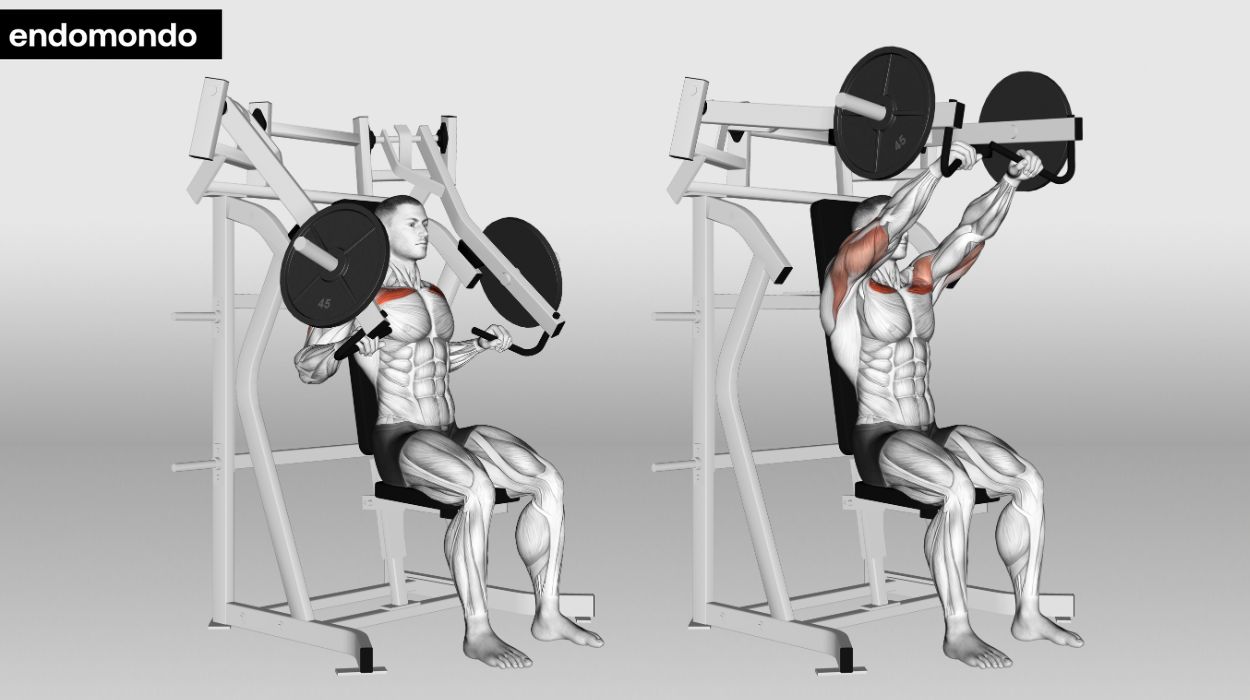
How to do:
- Select a suitable resistance on the chest press machine.
- Place your feet flat on the ground at around shoulder width apart.
- Sit back on the machine and grasp the handles using an overhand grip.
- Press the handles forward and the machine will naturally guide a movement that targets the upper chest.
- Slowly bring the handles back to the starting position.
- Repeat for the desired number of reps.
Tips:
- Ensure your bench is set at a comfortable incline angle (usually around 30-45 degrees) to target the upper chest effectively while providing proper shoulder support.
- Keep your back flat against the bench and maintain a stable grip on the handles, focusing on controlled movements to prevent excessive arching or swaying.
- Perform the exercise with a full range of motion by lowering the weight until your elbows are at or slightly below chest level and pressing it upward until your arms are fully extended for optimal upper chest engagement.
Optimal Sets and Reps: 3 sets of 10-12 reps.
Benefits Of Upper Chest Training
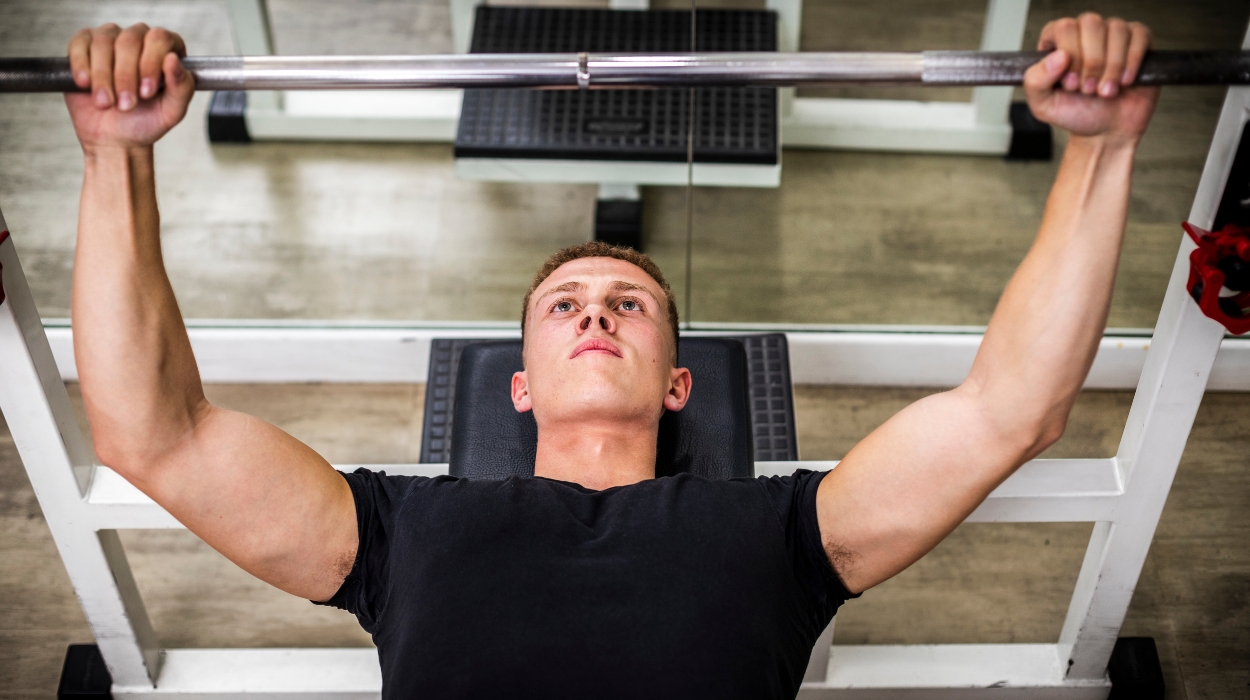
Overall Chest Development
As we mentioned, neglecting the upper chest workout can give an odd appearance with an overpowering lower chest. Including upper chest exercises can help build a more complete and well-rounded appearance of the chest.[1]
Help Stabilize The Shoulder Joint
The upper chest[2] connects to the clavicles/shoulders, which helps to stabilize the shoulder joint from the front. This in turn can reduce the risk of shoulder injury in times when the shoulder joint pulls backwards.
Tips For Doing Upper Chest Workouts
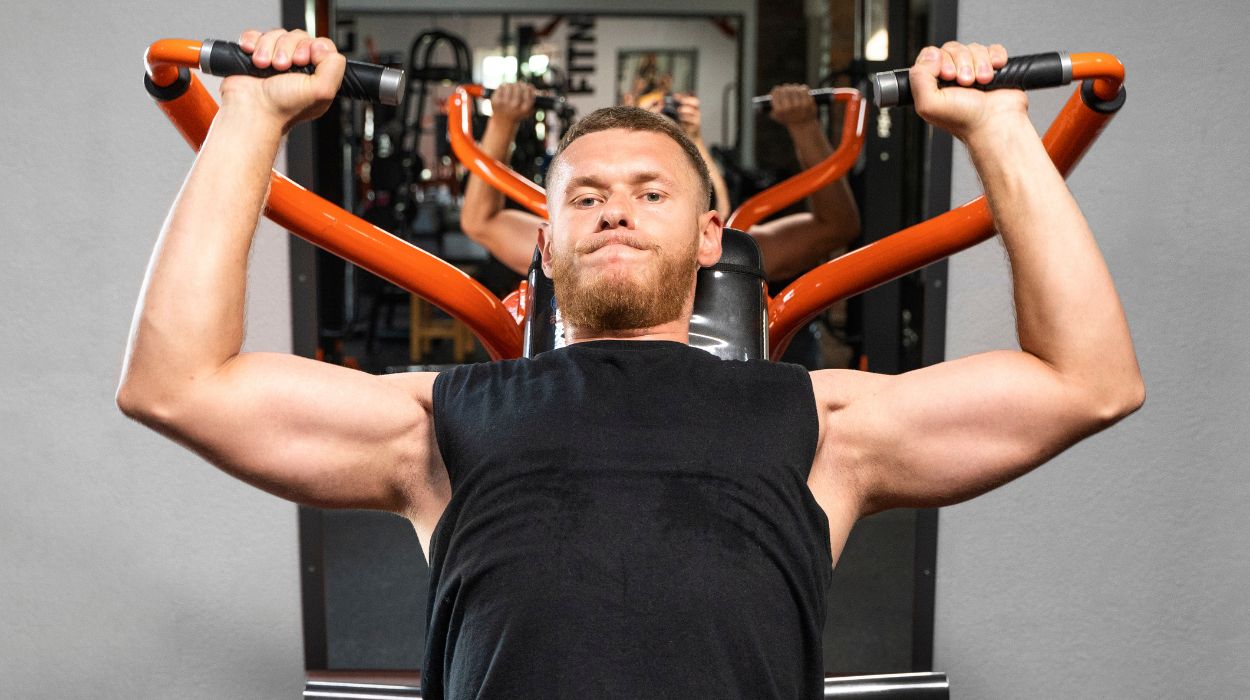
Since these exercises target an often neglected area of the chest, using less common angles, it is important to be mindful of the technique and weight used during an upper chest workout. If you do this, not only will it ensure a safe workout, but it will also help to realize the greatest gains.
Keep The Elbows Tucked
The upper chest tendons and ligaments are connected to the collarbones and shoulders and, thereby are activated by the upper arm moving forward. When doing any upper chest pressing or fly movement, make sure your elbows are tightly controlled and stabilized.
Keep The Elbows Slightly Bent During Fly Based Exercises
During the chest flies, it is important to keep the elbow joint slightly bent and sufficiently stabilized. This simple strategy will halt the lower arm from overstretching and becoming injured.
Core Bracing Techniques
Bracing the core[3] is one of the most crucial tips for upper chest training, or any type of exercise for that matter. Bracing the core throughout the movement will ensure that the spine stays in a safe and neutral position, preventing loading/curving and injury.
Breathing Techniques
When doing these exercises, take a deep and hold a deep breath while pressing, forcefully release some of the breath during the press, finally followed by releasing the breath completely while bringing the weight down.
I know breathing seems like something you shouldn’t have to focus on, but natural restraining of breath during these exercises can deprive the body and brain of important oxygen, which can be very dangerous.
Warm Up
We all want to skip to the good part, but let us not undervalue the importance of warming up the upper chest and shoulders before your workout. Low-intensity upper chest and shoulder rotation movements can help lubricate the joints with synovial fluid and warm the muscles/core body temperature. Overall, this improves the flexibility of the body, lowering the risk of injury when you work at higher intensities.
Observe Good Nutrition
A lifter must observe a well-balanced and calorie-controlled diet to lose fat around the stomach and chest if they want to have any chance at achieving the muscle definition they are looking for.
Start your day with a healthy breakfast full of micronutrients, carbohydrates, and protein, and keep that mindset throughout the day, making appropriate food and beverage choices that help to attain your goals, not get in their way.
Conclusion
Upper chest training is crucial in creating a well-developed chest and shoulder stability. The five exercises that we covered when incorporated into a healthy lifestyle, can help to provide that balance and build the upper portion of the chest.
While the exercises are very important, following some important tips can help to make your experience with these exercises much more successful. Now, don’t wait any longer. If you leave now, you can still make it to the gym in time!
Frequently Asked Questions
Both heavy lifting with lower reps and lighter lifting with higher reps can help develop the upper chest by tapping into different training mechanisms (mechanical stress vs. metabolic stress).
It depends on your training level. For beginners, once a week should do the trick. However, more advanced lifters may need to train the upper chest twice or three times per week to see improvements.
Resources
- Pascal Schütz, Zimmer, P., Zeidler, F., Plüss, M., Oberhofer, K., List, R. and Silvio Rene Lorenzetti (2022). Chest Exercises: Movement and Loading of Shoulder, Elbow and Wrist Joints. Sports, [online] 10(2), pp.19–19. doi:https://doi.org/10.3390/sports10020019.
- Baig, M.A. and Bordoni, B. (2023). Anatomy, Shoulder and Upper Limb, Pectoral Muscles. [online] Nih.gov. Available at: https://www.ncbi.nlm.nih.gov/books/NBK545241/.
- Bliss, L.S. and Teeple, P. (2005). Core Stability. Current Sports Medicine Reports, [online] 4(3), pp.179–183. doi:https://doi.org/10.1097/01.csmr.0000306203.26444.4e.




